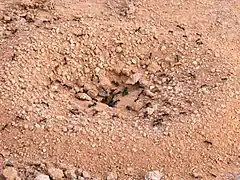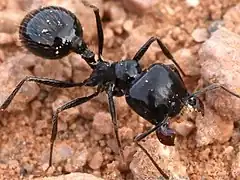| Messor pergandei | |
|---|---|
 | |
| M. pergandei worker from the United States | |
| Scientific classification | |
| Domain: | Eukaryota |
| Kingdom: | Animalia |
| Phylum: | Arthropoda |
| Class: | Insecta |
| Order: | Hymenoptera |
| Family: | Formicidae |
| Subfamily: | Myrmicinae |
| Genus: | Veromessor |
| Species: | V. pergandei |
| Binomial name | |
| Veromessor pergandei (Mayr, 1886) | |
Veromessor pergandei is a species of harvester ant native to the Southwestern United States, especially the deserts of southeastern California. It has also been identified in the Baja California peninsula of Mexico.[1] It was first described by Gustav Mayr, who named it Aphaenogaster pergandei.[2][3] It can also be referred to as a black harvester ant or desert harvester ant, although these common names have also been applied to other species.[4][5]
Description
V. pergandei has a head of equal length and width, with very large mandibles. It has short white or yellow hair and a large thorax. Males typically measure about 8.5 mm (0.33 in) and females about 10 mm (0.39 in).[1] However, individual size can vary based on factors such as availability of food and interspecific competition. The species is named after American myrmecologist Theodore Pergande.[6] The genus was for some time synonymized under Messor but has been split out based on a 2015 study.[7]
 nest mound
nest mound worker
worker
Ecology
Like other harvester ants, V. pergandei gathers fruits and seeds for food. The seeds of perennial shrubs such as Larrea tridentata and Ambrosia dumosa are included in its diet.[8]
References
- 1 2 Wheeler, William Morton; Creighton, William Steel (1934). "A study of the ant genera Novomessor and Veromessor" (PDF). Proceedings of the American Academy of Arts and Sciences. 69 (9): 341–387. doi:10.2307/20023057. JSTOR 20023057. Retrieved 10 January 2013.
- ↑ Mayr, Gustav (1886). "Die Formiciden der Vereinigten Staaten von Nordamerika" (PDF). Verhandlungen der Kaiserlich-Königlichen Zoologisch-Botanischen Gesellschaft (in German). Vienna. 36: 419–464. Retrieved 10 January 2013.
- ↑ "Veromessor". AntWiki. Retrieved 10 January 2013.
- ↑ Lighton, J.R.; Bartholomew, G.A. (1988). "Standard energy metabolism of a desert harvester ant, Pogonomyrmex rugosus: Effects of temperature, body mass, group size, and humidity". Proceedings of the National Academy of Sciences of the United States of America. 85 (13): 4765–4769. Bibcode:1988PNAS...85.4765L. doi:10.1073/pnas.85.13.4765. PMC 280516. PMID 16593953.
- ↑ "Black Harvester Ant". Orkin. Archived from the original on 30 August 2012. Retrieved 10 January 2013.
- ↑ Davidson, Diane W. (1978). "Size variability in the worker caste of a social insect (Veromessor pergandei Mayr) as a function of the competitive environment". The American Naturalist. 112 (985): 523–532. doi:10.1086/283294. S2CID 84302379. Retrieved 10 January 2013.
- ↑ Ward, Philip S.; Brady, Seán G.; Fisher, Brian L.; Schultz, Ted R. (2015). "The evolution of myrmicine ants: phylogeny and biogeography of a hyperdiverse ant clade (Hymenoptera: Formicidae): Phylogeny and evolution of myrmicine ants". Systematic Entomology. 40 (1): 61–81. doi:10.1111/syen.12090. S2CID 83986771.
- ↑ Wissinger, Benjamin D. (2012). Perennial shrub and harvester ant responses to environmental gradients in southern California deserts (Thesis). University of Idaho. OCLC 823874661.
External links
- Messor pergandei at AntWeb
- "Oldstyle id: 6879700". Catalogue of Life. Species 2000: Leiden, the Netherlands.